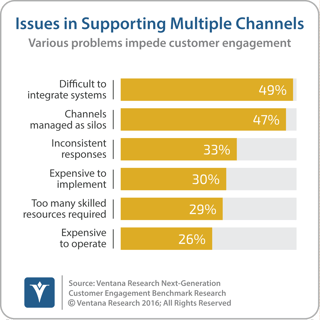A lot is being written and said about the omnichannel customer experience and the role contact center agents play in providing such experiences. From the customer’s perspective, I think it boils down to four things: that the interaction is easy, personal to them, within the context of the relationship and previous interactions, and consistent no matter with whom or what technology they interact. From the agent or user’s perspective, it should be easy to find the information needed to resolve the interaction to the customer’s satisfaction, and he or she must be empowered to resolve any issues that arise.
Our research into next-generation customer engagement finds that three major obstacles  get in the way of meeting both customers’ and agents’ expectations. First, most organizations have multiple systems that contain customer data and these are often unconnected, making it difficult for agents to find the information they need. Second, organizations frequently use multiple systems to manage the different channels of engagement and, once again, these are largely managed as silos, making it difficult for agents to see what responses customers gave during previous interactions. Add these two together and this creates the third, key, issue: Customers get different responses depending on whom they interact with. This last issue has potentially serious consequences, such as customers becoming angered even to the point of being abusive with agents, customers jumping across channels looking for the answer they want, degradation of the customer experience, negative comments on social media and possible termination of doing business.
get in the way of meeting both customers’ and agents’ expectations. First, most organizations have multiple systems that contain customer data and these are often unconnected, making it difficult for agents to find the information they need. Second, organizations frequently use multiple systems to manage the different channels of engagement and, once again, these are largely managed as silos, making it difficult for agents to see what responses customers gave during previous interactions. Add these two together and this creates the third, key, issue: Customers get different responses depending on whom they interact with. This last issue has potentially serious consequences, such as customers becoming angered even to the point of being abusive with agents, customers jumping across channels looking for the answer they want, degradation of the customer experience, negative comments on social media and possible termination of doing business.
Based on my experience and research, I believe there are two potential solutions: either making radical changes to the organization’s system architecture and processes or deploying what I call a “smart” agent desktop. The first can be very disruptive, risky and costly, whereas deploying a smart desktop is far less disruptive and can also be less costly and risky.
Several years ago, Verint acquired a vendor that offered an early version of such a system. Recently it released an updated version of it, called Employee Desktop. This latest version has lots of new features, but the key for me is that it has been upgraded to be truly omnichannel. It includes point-and-click access to any of the channels of engagement (telephone, email, text, etc.) on which the agent or other user is authorized to handle interactions and users can seamlessly switch as needed between channels – for example, from a chat session to a call. Thus, agents can give customers the same information regardless of channel.
The Employee Desktop also provides point-and-click access to data held in any business application, including access to an internal knowledge management system that can act a single source of information, providing product information, answers to common questions and more. These capabilities reduce the need for users to search for the data they need to resolve interactions. The system can be set up to use information retrieved or entered by the user to automatically provide context to the interaction in the form of, for example, key customer demographics and previous interactions from the same caller. It can then provide guidance on agent responses as well as billing information or upsell opportunities. The system also includes case management and workflow capabilities so that if the user cannot resolve the interaction, he or she can create a case to ensure action is taken to resolve the caller’s issue.
The capabilities offered in this new version address both sides of interaction handling: The customer experience improves because issues are resolved more quickly, and the agent’s experience is improved because he or she will have less difficulty finding the information needed to resolve interactions. The system can also be set up so that all users follow the same process, ensuring customers have consistent experiences.
Our benchmark research into the contact center in the cloud confirms that customer experience has become the arena in which most companies (70%) now expect to compete for customers. It also confirms that many interactions still happen over the telephone. It is therefore vital that organizations ensure call handling meets customer expectations and is done in a way that hits operational targets such as first-contact resolution rates. As simpler interactions are more often resolved using digital self-service channels and users increasingly handle more complex interactions, I believe using a smart desktop system is the least disruptive and most effective way to attain those targets. I therefore recommend all organizations evaluate how the latest release of the Verint desktop product can help improve the handling of telephone calls and all other forms of interactions and, in doing so, deliver true omnichannel experiences.
Regards,
Richard Snow
VP & Research Director, Customer Engagement
Follow Me on Twitter and Connect with me on LinkedIn










